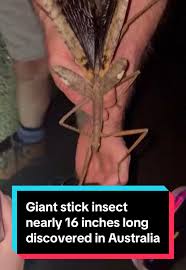
Introduction
The Australian stick insect, a remarkable example of nature’s ingenuity, plays a significant role in the biodiversity of Australia’s ecosystems. Known for their incredible ability to blend into their surroundings, these insects are not only fascinating but also important for understanding ecological balance. Their unique adaptations and behaviours reflect the evolutionary paths taken by various species amidst the continent’s diverse habitats.
Physical Characteristics and Habitat
Australian stick insects, belonging to the Phasmatodea order, are masters of camouflage, resembling twigs or branches as a survival strategy against predators. They can range in colour from green to brown, depending on their habitat, allowing them to seamlessly integrate into their environment. Adult stick insects may reach lengths of up to 25 cm, with some even more noticeable due to their large size.
These insects can be found throughout Australia, inhabiting forests, woodlands, and scrublands, with their distribution being influenced by the availability of suitable foliage. Their preferred diet primarily consists of leaves, particularly from eucalyptus trees, which provide not only sustenance but also support their camouflage due to similar colours and textures.
Behaviour and Reproduction
Stick insects are mostly nocturnal, spending their nights feeding and their days in a state of stillness, mimicking twigs to avoid detection. During mating season, which can span from late spring to early autumn, males employ various methods to attract females. Interestingly, many species of stick insects are parthenogenetic, meaning females can reproduce without male fertilisation, leading to the creation of genetically identical offspring.
Each female can lay hundreds of eggs, which are often dropped to the ground to mimic seeds, further aiding their survival as they go through a series of molts before reaching maturity. The lifespan of a stick insect typically lasts from 6 months to a year, depending on the species and environmental conditions.
Conservation Status
While many Australian stick insect species are widespread and not currently threatened, habitat loss and climate change pose potential risks to their populations. Conservation efforts, which include habitat preservation and public education, are vital in ensuring that these extraordinary insects continue to thrive.
Conclusion
The Australian stick insect serves as a testament to the remarkable adaptability of life in the face of various environmental pressures. Their fascinating characteristics and behaviours not only add to the rich tapestry of Australia’s wildlife but also underscore the importance of conserving their habitats. As climate change continues to affect ecosystems globally, understanding and protecting such unique species will be crucial in maintaining ecological balance and biodiversity for future generations.
You may also like

Understanding Mosquera Wolves and Their Conservation Needs

The Unique Biodiversity and Culture of Madagascar
